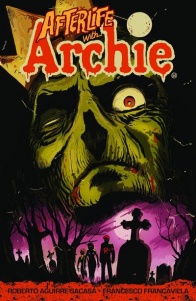Despite there being a plethora of Archie comics out there, I’ve never read any of them. Sure, that relaunch with Fiona Staples artwork was tempting, with a handful of other intriguing miniseries following that, but I’m yet to sit down and read any. I’ve read “Criminal: The Last of the Innocent,” which has its Archie links but for better or worse, when it comes to the town of Riverdale, the only real experience I have is with the CW’s darker teeny reimagining. Looking over the recent Archie series, I was struck by Francavilla’s cover for #1 of “Afterlife with Archie.” With my interest piqued by another dark take on the town of Riverdale, I dived in.
Afterlife with Archie #1-5Cover by Francesco Francavilla
Written by Roberto Aguirre-Sacasa
Illustrated by Francesco Francavilla
Lettered by Jack Morelli
Reviewed by Luke Cornelius
“Afterlife with Archie” is everything you’d imagine it to be; it’s Riverdale being overrun by zombies and, with Francavilla illustrating the book, there’s no holding back the horror in this reimagining.
Issue #1 sets the tone by opening with an ominous written-in-blood title page that reads “This is how the end of the world begins.” Francavilla follows up with a page compiled of small and tense panels draped in shadows and washed with his trademark glowing red and muted blue which further the atmosphere generated by the title page. The tension builds across the page before we are confronted by a dramatic splash page showing an exhausted Jughead arriving at the Spellman house, with Hot Dog dripping in blood.
Unlike other zombie stories which see the outbreak given scientific origins, the source of the zombies here is magick and, more significantly, human emotion. Sabrina acts against her aunts’ wishes by performing necromancy because she relates to Jughead’s loss through her bond with Salem. By giving the outbreak this source, before the horrors have begun in earnest, “Afterlife with Archie” ensures it has the characters at its core and its something it maintains throughout its first arc. It’s not something I had expected the series to do, but the series is all the better for it as it never loses its Archie Comics identity.
Aguirre-Sacasa keeps the strong sense of identity through the narration too. In each issue after the first, which only uses timestamps counting down to the “contagion,” there’s a different character narrating to give each issue a different feel. Take issue #2 for example; it’s narrated in retrospect by Veronica, who, when detailing the horrific events of the Halloween Ball, is blinded by the fact that “holier-than-thou Betty leapt into action” to show how “incompetent [the rest of us] are in a crisis.” There’s always drama and conflict from the regular Archie stories prominent, with a zombie outbreak being the least of any character’s problems.
If you think this all sounds a bit too Archie for a comic dealing with zombies, fear not. Francavilla’s artwork beneath the narration means the horrific reality is always present. The cast look identifiable with their “Life with Archie” counterparts until the apocalypse hits. Francavilla’s zombiefied Jughead looks groteseque, with his bitten arm even further deformed and decayed while his face has sunk to the bone. Only his ever-present crown reminds the reader of who he used to be. This design left me wanting to see how Francavilla would present each character as a zombie, but fearing the tragic ends that would be required to do so.
As the series progresses, the darkness that has been consuming the panels starts to catch up with Aguirre-Sacasa’s scripts and characters start succumbing to the pressures of the rapidly-changing status quo. Smithers is left with no option but to defy Hiram, Veronica’s mask of normality starts to slip, and Archie is forced to do the unthinkable.
The balancing act between the Archie identity and horror that the creative team perform works best in issue #4. In this issue, there are two powerful scenes depicting two deaths in the Andrews family. As a dog lover myself, Jughead’s desperation to revive Hot Dog was emotional and relatable, but the heroic stand by Vegas against zombiefied Hot Dog turns it up to 11. It is one of the most heartbreaking sequences I’ve experienced in comics. Francavilla’s colors on the initial pages of the issue fade from a soft yellow glow in Archie’s childhood when he met Vegas, to a muted blue present with Hot Dog snarling in a hellish red glow, before all the panels become engulfed in red as Vegas and Hot Dog fight. This color change elevates the story set out in the script, with the inevitability of Vegas’ demise becoming ever clearer. Francavilla’s panel work here is also fantastic, with two successive pages with 9 panel grids showing the fragments of violence. In the penultimate panel of the sequence, there’s a heart-wrenching close-up panel of Vegas which conveys his panic about Archie’s safety. With the 9 panels not allowing for much room for word balloons or sound effects, Morelli positions them without detracting from the emotion that Francavilla expresses in the art.
Part of what makes this emotional feat all the more incredible, is that Francavilla then has a 15 panel page later in the issue presenting the second death in Archie’s family that still has the huge emotional impact it needs.
There’s something highly addictive produced by the series’ ability to blend the (melo)drama, relatability, and heart of the Archie characters with the horrific circumstances that are presented through glorious Francavilla artwork that, upon reaching the conclusion of “Afterlife with Archie”’s first arc, you won’t be able to resist looking for the next.







